Voter Turnout Chapter Notes | AP U.S Government and Politics - Grade 12 PDF Download
| Table of contents |

|
| Introduction |

|
| How Laws Shape Voter Turnout |

|
| Demographic and Psychological Influences on Turnout |

|
| Voter Choice: Why People Choose the Candidates They Do |

|
Introduction
The U.S. Constitution guarantees the right to vote, but possessing this legal entitlement does not ensure that individuals will actually participate in elections. Voter turnout fluctuates considerably across different elections, influenced by a variety of factors including state regulations, personal demographics, and perceptions of political efficacy, which collectively determine whether citizens choose to cast their ballots.
How Laws Shape Voter Turnout
While federal laws establish certain parameters, states hold significant authority over the electoral process. Legal frameworks, registration requirements, and election types play a critical role in determining the level of voter participation in the United States.
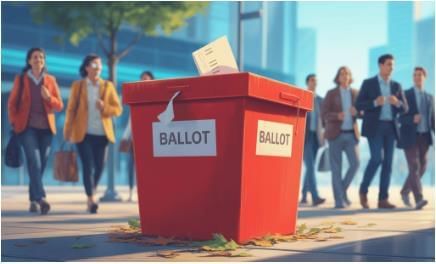
Federal vs. State Control of Elections
- States wield considerable control over elections, managing key aspects such as:
- Establishing deadlines for voter registration.
- Setting hours for polling places.
- Determining requirements for voter identification.
- Overseeing mail-in and early voting options.
- Drawing boundaries for U.S. House election districts.
- Due to these varying state policies, access to voting and turnout rates differ across the country. For instance, states offering same-day registration and extensive early voting typically experience higher turnout compared to those with stringent voter ID requirements and restricted registration periods.
- The federal government, however, retains an important role by enacting major voting rights laws, enforcing constitutional amendments such as the 15th, 19th, and 26th, and regulating campaign financing through legislation like the Federal Election Campaign Act and the Bipartisan Campaign Reform Act.
Voter Registration Laws and Procedures
State voter registration laws significantly affect turnout, with some states simplifying the process and others creating obstacles.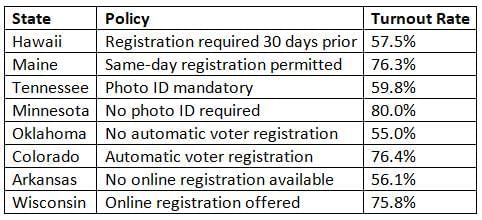
Key Point: Policies such as automatic and online voter registration reduce barriers, generally boosting turnout. These measures are most effective when combined with voter education and accessible polling options.
Voting Incentives and Penalties
To encourage voting, some jurisdictions offer incentives like time off work, free transportation, or raffles, while others impose minor fines for non-voting. The success of these strategies depends on public confidence in the electoral system.
- California provides up to two hours of paid leave for employees to vote.
- Maryland offers free transportation to polling stations in select cities.
- Seattle has piloted voucher programs to reward civic engagement.
While these initiatives can promote participation, excessive or coercive penalties may undermine the legitimacy of the political process.
Presidential vs. Midterm Elections
Presidential elections consistently attract higher voter turnout than midterm or local elections.
Key Point: The 2020 presidential election saw approximately 66% turnout among eligible voters, while the 2018 midterm elections reached about 50%, an unusually high figure for midterms.
Factors contributing to this disparity include:
- Increased media attention on presidential races.
- Greater perceived importance of presidential elections.
- Lower public awareness of local and congressional races.
Additionally, voters with low political efficacy—those who doubt their vote will make a difference—are less likely to participate, particularly in non-presidential elections.
Demographic and Psychological Influences on Turnout
In addition to legal and institutional factors, voter turnout is shaped by individual characteristics, including demographics, ideology, and political awareness.
Factors That Predict Turnout
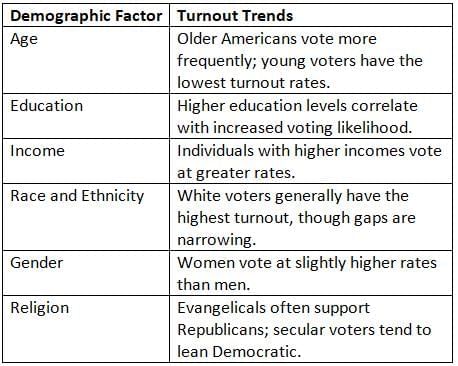
Political Efficacy and Engagement
- Political efficacy refers to the belief that one’s participation in the political process can have an impact. Individuals with high political efficacy are more likely to vote, while those who distrust the system or feel overlooked by elected officials may choose not to participate.
- Efforts such as civic education, community organizing, and media campaigns can enhance political efficacy and boost voter engagement.
Voter Choice: Why People Choose the Candidates They Do
Among those who vote, candidate preferences vary based on personal and political factors. Understanding these choices helps explain turnout patterns and party support.
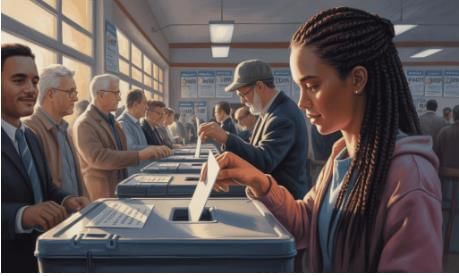
Party Identification
Party loyalty is a primary driver of voter behavior. Most Americans who identify with a political party consistently vote for its candidates across the ballot, often engaging in straight-ticket voting.
Key Point: Straight-ticket voting involves selecting all candidates from one party, rather than assessing each race individually.
Candidate Characteristics
Modern campaigns increasingly focus on individual candidates. A compelling personal story, charismatic demeanor, or effective media strategy can increase turnout and influence undecided voters.
Voters often respond to:
- A candidate’s experience.
- Their appearance and communication style.
- Their personal background and narrative.
Religious Beliefs, Gender, and Race
These factors shape long-term voting trends:
- Evangelical Christians tend to back Republican candidates, particularly on issues like abortion and school prayer.
- Black voters overwhelmingly support Democrats, especially in presidential elections.
- Women are more likely to vote for Democratic candidates than men, a phenomenon known as the gender gap, often linked to differences in views on social policies, healthcare, and criminal justice.
How Laws Shape Voter Turnout
While federal laws provide a framework, states have significant autonomy in managing elections, and their decisions, particularly around voter registration, can either facilitate or hinder participation.
Federal vs. State Control of Elections
States have authority over several election-related aspects, including:
- Voter registration deadlines and processes.
- Access to early and mail-in voting.
- Availability and staffing of polling locations.
- Requirements for voter identification.
These policies can either promote or suppress turnout, depending on their inclusivity or restrictiveness. For example, same-day registration often increases participation, while strict ID laws may reduce it, particularly among historically disenfranchised groups.
Political parties hold divergent views on these policies:
- Democrats typically advocate for measures that simplify registration and voting, such as automatic registration, online registration, early voting, mail-in ballots, and same-day registration, arguing these enhance democratic access and boost participation across diverse communities.
- Republicans often support stricter voting regulations, including rigorous voter ID laws, limited registration periods, and restrictions on absentee voting, emphasizing the prevention of voter fraud, though studies indicate fraud is rare. Critics contend these measures disproportionately lower turnout among low-income, minority, and young voters.
Voter Registration Policies and Their Effects
Voter registration laws are among the most influential factors affecting turnout, as the ease of registration can determine whether someone votes at all.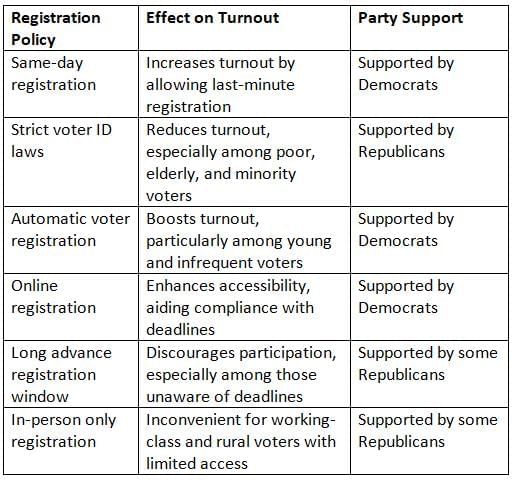
Key Point: Real-world impact: Maine, with same-day registration, achieved a 76.3% turnout rate, while Hawaii, requiring registration 30 days in advance, had a turnout of 57.5%.
These examples demonstrate that voter registration laws not only determine eligibility but also influence actual participation. Accessible registration processes tend to increase turnout, particularly among younger voters, renters, and working-class individuals, who are more likely to support Democratic candidates. Restrictive policies often suppress turnout among these groups, potentially preserving Republican electoral advantages in certain states.
Conclusion
Voter turnout results from a complex interplay of individual motivation, legal structures, and institutional access. Factors ranging from state election laws and voter ID requirements to party loyalty and personal beliefs collectively shape who participates and who abstains. Understanding these dynamics not only clarifies how elections are decided but also illuminates the distribution of political power within a democratic society.
Key Terms
- Automatic Voter Registration (AVR): A system that automatically enrolls eligible citizens to vote during interactions with government agencies, such as the Department of Motor Vehicles, aiming to simplify registration and increase turnout by reducing barriers.
- Campaign Finance Rules: Regulations governing financial contributions to political campaigns, ensuring transparency, curbing corruption, and promoting fair competition, which influence voter turnout through campaign engagement strategies.
- Candidate-Centered Election: An election where individual candidates, rather than parties, dominate, with voters focusing on candidates’ personalities, qualifications, and charisma, potentially boosting turnout through personal appeal.
- Civil Rights Legislation: Laws protecting against discrimination based on race, gender, disability, or age, promoting equal voting access and influencing turnout by ensuring nondiscriminatory participation.
- Closed Primary Elections: Elections where only registered party members can vote in their party’s primary, reinforcing party loyalty but potentially limiting broader participation.
- Constitutional Amendments: Formal changes to the Constitution that modify or expand its provisions, shaping voter turnout by establishing legal frameworks for voting rights.
- Contemporary Political Issues: Current debates and policies shaping governance, with voter turnout being a key issue affecting democratic representation and elected officials’ legitimacy.
- Gender Gap: Differences in political opinions and voting behavior between men and women, influencing turnout and electoral outcomes, with women often favoring Democrats.
- Ideological Orientation: A set of beliefs and values guiding political preferences, shaping voting behavior and engagement with the electoral process.
- Midterm Elections: Elections held midway through a president’s term, determining Congress’s composition and reflecting public sentiment, typically with lower turnout than presidential elections.
- National Elections: Federal-level elections, including presidential and congressional races, shaping national policy and reflecting voter engagement, with turnout impacting governance legitimacy.
- National Voter Registration Act: A 1993 law enhancing voter registration opportunities through government agencies, simplifying the process to boost turnout and electoral access.
- Open Primary Elections: Primaries allowing voters to participate regardless of party affiliation, potentially increasing turnout by broadening electoral engagement.
- Online Voter Registration: Internet-based voter registration through state websites, enhancing accessibility and efficiency, thereby increasing turnout by reducing registration barriers.
- Party Identification: Psychological attachment to a political party, influencing voting behavior and turnout through consistent party loyalty.
- Political Efficacy: The belief that one’s political actions can influence governance, with higher efficacy correlating with increased voter participation.
- Presidential Elections: Elections to select the president, involving primaries and general voting, reflecting democratic engagement and influencing government branches through voter sentiment.
- Religion, Gender, Race & Ethnicity: Social categories shaping political identities and turnout, with varying participation patterns among groups like evangelicals, Black voters, and women.
- Same-Day Registration: A process allowing voters to register and vote on Election Day, reducing barriers and increasing turnout by accommodating last-minute participation.
- State and Federal Laws: Legal frameworks governing voting, with state regulations on registration and access impacting turnout alongside federal protections for voting rights.
- State-Controlled Elections: Elections managed by state governments, with rules on voter ID, registration, and polling affecting turnout through varying levels of accessibility.
- Voter Registration Laws and Procedures: Legal requirements for voter registration, such as age, residency, and deadlines, directly influencing turnout by determining electoral eligibility and ease of participation.
- Voter Identification Requirements: Laws mandating specific IDs for voting, which can facilitate or hinder turnout, particularly affecting marginalized groups without easy access to required identification.
- Voting Incentives or Penalties or Fines: Mechanisms to encourage or discourage voting through rewards like tax breaks or penalties like fines, aiming to boost turnout but requiring careful implementation to maintain political legitimacy.
FAQs on Voter Turnout Chapter Notes - AP U.S Government and Politics - Grade 12
| 1. What are some key factors that influence voter turnout in elections? |  |
| 2. How do state and federal laws impact voter turnout? |  |
| 3. What are some common barriers to voting that affect turnout? |  |
| 4. How does public awareness and education affect voter choice? |  |
| 5. What are some strategies to increase voter turnout? |  |














